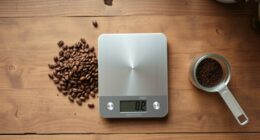If you're wondering how much 10 grams of yeast is in teaspoons, it's about 3.2 to 3.3 teaspoons for dry yeast. This measurement is key when you're following baking recipes. Keep in mind that different types of yeast can vary slightly in density, impacting conversions. Using a kitchen scale is a smart move for accuracy. Also, if you're working with fresh yeast, remember that 30 grams equals 10 grams of dry yeast. Knowing these conversions can make a big difference in your baking success, and there's plenty more to explore regarding yeast and its role in your recipes.
Key Takeaways
- 10 grams of dry yeast is approximately 3.2 to 3.3 teaspoons.
- A standard packet of active dry yeast weighs about 7 grams, equating to 2.25-2.5 teaspoons.
- Use level teaspoons for consistent yeast measurements to avoid discrepancies.
- Different yeast types may have varying densities, affecting volume-to-weight conversions.
- For precise baking, using a kitchen scale is recommended for measuring yeast accurately.
Understanding Yeast Measurements
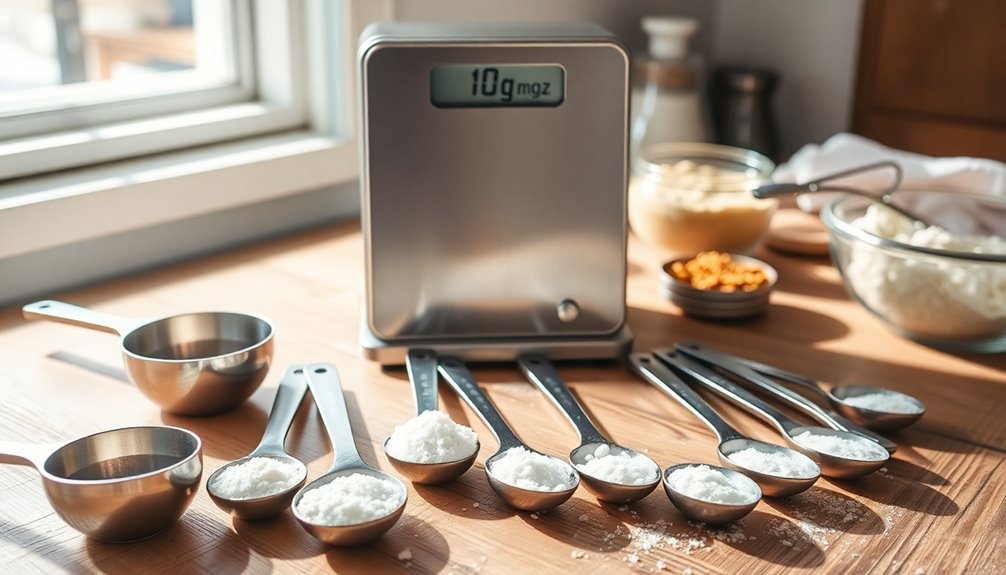
When it comes to baking, understanding yeast measurements is essential for achieving the best results.
You’ll find that ten grams of dry yeast is approximately equal to 3. 2 to 3. 3 teaspoons. Since a standard teaspoon holds about 2. 8 grams of dry yeast, you need to be precise with your measurements. This precision is especially important when it comes to baking, as small variations in yeast measurements can greatly affect the outcome of your bread or pastries. To ensure accuracy, it’s helpful to familiarize yourself with yeast conversion for baking, and to use a reliable kitchen scale for precise measurements. Understanding how to properly measure and convert yeast will help you achieve consistent and delicious results in your baking endeavors.
For accurate conversions, remember that 7 grams of dry yeast translates to roughly 2.25 teaspoons. Always use level teaspoons to guarantee consistency in your baking outcomes.
Additionally, understanding yeast density variations can help you measure correctly when converting between grams and teaspoons.
Yeast Types Overview

Yeast comes in various types, each playing an essential role in baking.
You'll often use active dry yeast, the most common choice for home bakers. It needs activation in warm water before you add it to your dough.
Instant yeast is another popular option; it works quickly and can be mixed directly with dry ingredients, making it perfect for speedy recipes.
Fresh yeast, while favored for rich doughs, has a shorter shelf life and requires refrigeration.
Brewer's yeast, primarily used for brewing beer, also has a place in baking.
When measuring yeast types and amounts, remember that 10 grams of yeast can vary slightly in volume depending on the type, so keep that in mind for your recipes!
Conversion Factors for Yeast
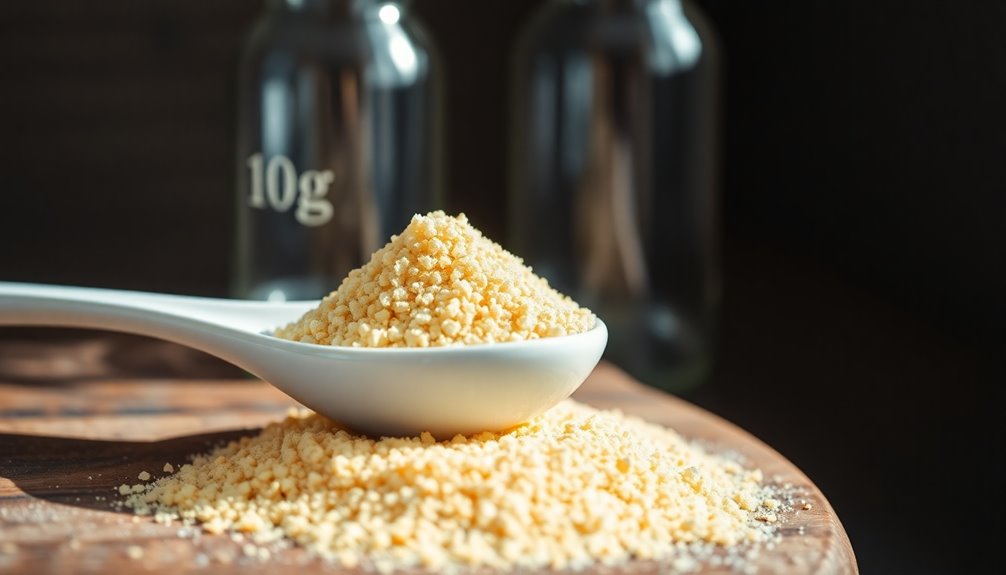
When you're measuring yeast, understanding conversion factors is essential for baking success.
Knowing that 10 grams of dry yeast equals about 3.2 teaspoons can help you adjust recipes easily.
To guarantee accuracy, always refer to specific measurement standards and consider using a scale for precise results.
Yeast Measurement Standards
Accurate yeast measurement is essential for achieving the desired results in baking. Knowing the yeast measurement standards helps you convert grams to teaspoons effectively. For instance, when dealing with dry yeast conversions, understanding the relationships between grams and teaspoons can greatly impact your baking success.
| Grams of Dry Yeast | Teaspoons Equivalent |
|---|---|
| 7 grams | 2.25 – 2.5 teaspoons |
| 10 grams | 3.2 – 3.3 teaspoons |
| 1 teaspoon | ~2.8 grams |
Different types of yeast may have varying densities, affecting conversion factors. By grasping these details, you can guarantee precise measurements, leading to successful fermentation and ideal dough texture in your baked goods.
Dry Yeast Conversions
Understanding dry yeast conversions is vital for achieving consistent baking results.
When you use dry yeast, remember that 10 grams converts to approximately 3.2 to 3.3 teaspoons. For standard conversions, 1 teaspoon of dry yeast is about 2.8 grams. To find the corresponding teaspoon measurement for dry yeast, simply divide the weight in grams by 2.8. This method is particularly helpful when scaling recipes.
A standard packet of dry yeast weighs 7 grams, which equals around 2.25 teaspoons, serving as a handy reference point.
Accurate measurements are important; using the right amount of dry yeast can greatly impact your dough's rise and flavor. Keep a Conversion Table handy to guarantee you're measuring correctly every time.
Importance of Accuracy
Getting the measurements right is essential in baking, as even minor discrepancies in yeast can lead to disappointing results.
When you measure yeast, remember that 10 grams equals approximately 3.2 to 3.3 teaspoons. This accuracy is vital because the right amount of yeast guarantees your dough rises properly and has the desired texture.
If you switch between fresh and dry yeast, understanding conversion factors becomes even more important. Consistency in measuring yeast helps maintain the fermentation and leavening effects you want in your baked goods.
Using conversion tables or calculators can streamline the process, giving you quick references for yeast measurements. By prioritizing accuracy, you'll set yourself up for baking success every time.
10G of Yeast in Teaspoons
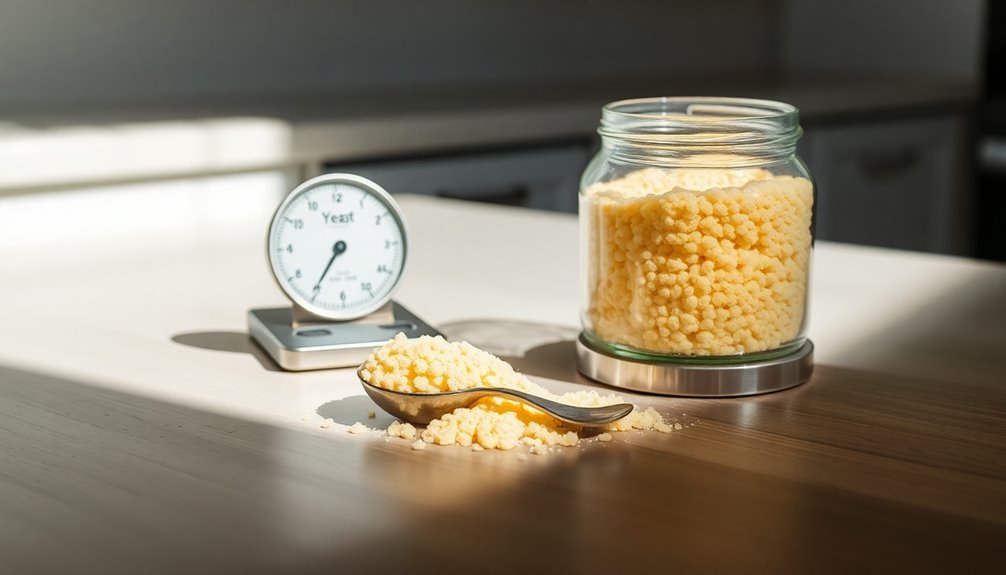
When you're measuring yeast for a recipe, it's vital to know that 10 grams of dry yeast is roughly equivalent to 3.2 to 3.3 teaspoons.
Since one teaspoon of dry yeast weighs about 2.8 grams, understanding this conversion can make your baking more precise.
Keep in mind that while the standard measurement for dry yeast is consistent, different yeast types may have slight density variations.
For the best results, consider using a digital scale to measure accurately, as volume can change based on how the yeast is packed into the teaspoon.
Accurate yeast measurements are essential; using too much or too little can affect your dough's rise and texture considerably.
Active Dry vs. Instant Yeast

Active dry and instant yeast are two popular choices for bakers, each offering distinct advantages. Active dry yeast needs hydration in warm water before use, while instant yeast can be mixed directly with dry ingredients. This makes instant yeast a time-saver for those enthusiastic to bake.
Here's a quick comparison:
| Type of Yeast | Weight per Packet | Teaspoons |
|---|---|---|
| Active Dry Yeast | 7 grams | 2.25 tsp |
| Instant Yeast | 10 grams | 3.2 tsp |
With a higher percentage of live cells, instant yeast ferments faster than active dry yeast. Both can be interchanged, but adjusting hydration and rising times is key for the best results.
Fresh Yeast to Dry Yeast
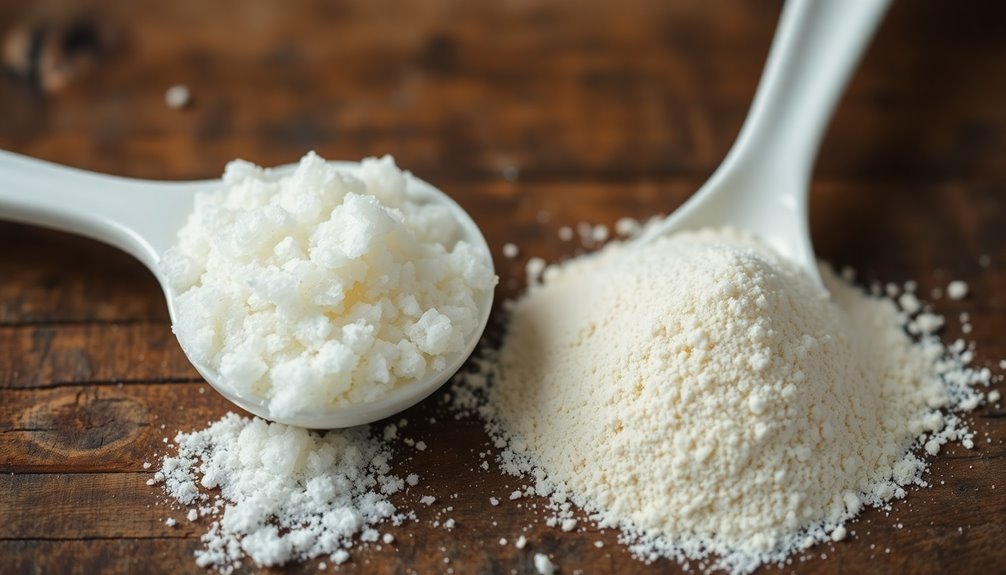
When you're converting fresh yeast to dry yeast, it's essential to understand the right ratios.
For instance, if you have 30 grams of fresh yeast, you'll only need 10 grams of dry yeast for the same leavening effect.
Let's break down how to measure fresh yeast accurately to guarantee your baking turns out just right.
Conversion Ratios Explained
Converting fresh yeast to dry yeast can be tricky, but understanding the right ratios makes it easier. When you need to switch from fresh yeast to dry yeast, remember that you should divide the amount of fresh yeast by 3.
For instance, 10 grams of fresh yeast translates to about 3.3 grams of dry yeast. Since one level teaspoon of dry yeast weighs approximately 2.8 grams, this means 10 grams of fresh yeast is roughly equivalent to 1.2 teaspoons of dry yeast.
These conversion ratios are essential for accurate baking. Keep in mind that fresh yeast usually requires proofing, while dry yeast can be added directly to your dry ingredients, simplifying the process for you.
Measuring Fresh Yeast
Measuring fresh yeast accurately is essential for achieving the perfect rise in your baked goods. Fresh yeast is typically dense, so 10 grams equals about 3.2 to 3.3 teaspoons.
If you're looking to convert fresh yeast to dry yeast, remember the ratio is 1:3; consequently, 10 grams of fresh yeast translates to roughly 3.3 grams of dry yeast.
Fresh yeast often comes in 42-gram cubes, making it easy to calculate for larger recipes. When you're substituting, 1 level teaspoon of dry yeast weighs around 2.8 grams, which simplifies your conversions.
Always measure fresh yeast precisely to maintain the desired fermentation and rise in your creations. Happy baking!
Measuring Yeast Accurately
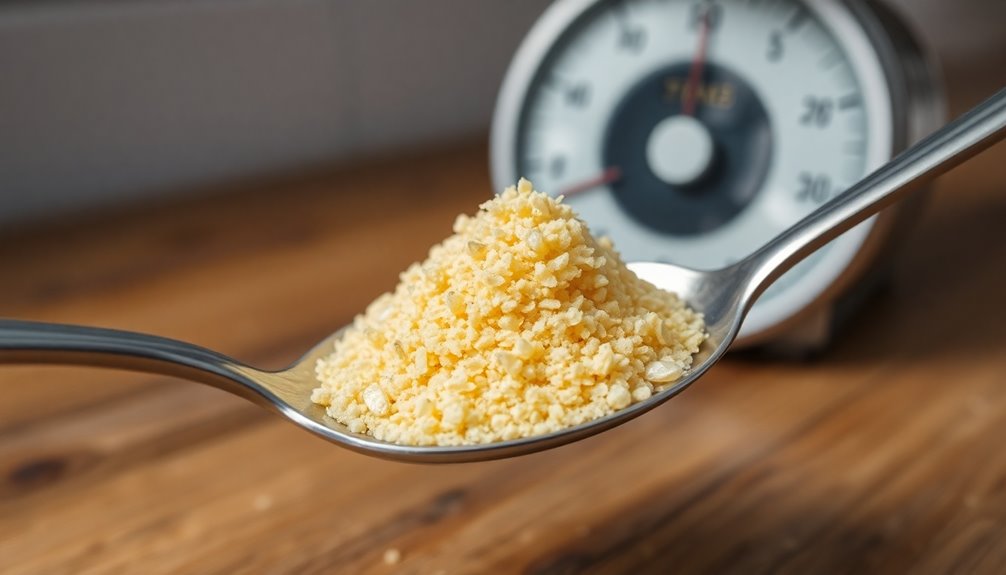
To achieve the best results in baking, knowing how to measure yeast accurately is essential. Here are some tips to help you get it right:
- Use level teaspoons to avoid discrepancies in volume measurement.
- Remember that 10 grams of dry yeast equals about 3.2 to 3.3 teaspoons.
- A standard packet of active dry yeast contains around 7 grams, or roughly 2.25 to 2.5 teaspoons—use this as a handy reference!
- Always verify your measuring spoons are dry and clean to maintain accuracy.
For the most precise results, consider using a kitchen scale, especially when measuring larger quantities.
Common Baking Conversions
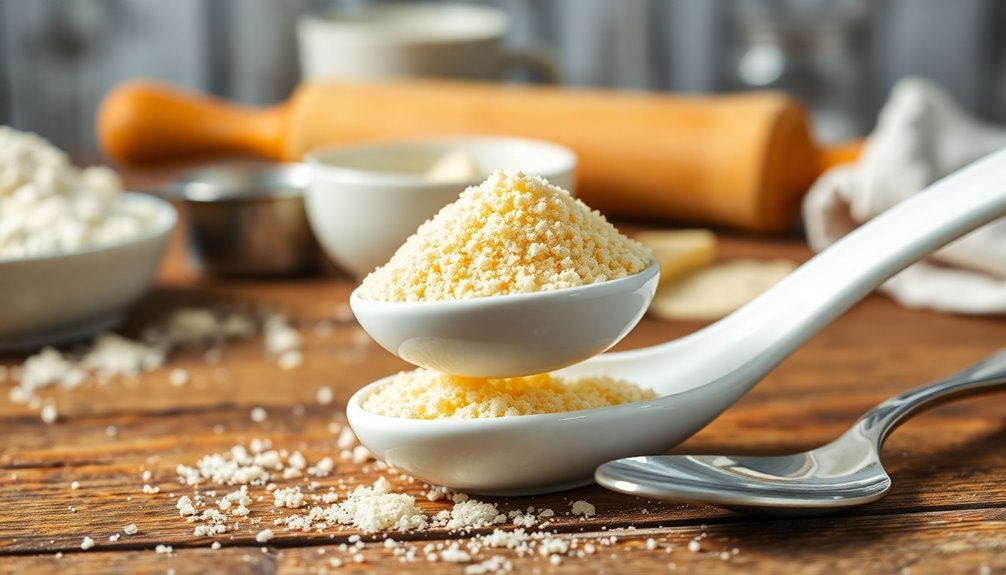
Accurate measurements are key in baking, especially when it comes to yeast and other ingredients. Yeast is typically measured in grams or teaspoons, and understanding these conversions guarantees your recipes come out just right. For instance, 10 grams of yeast is approximately 3.2 to 3.3 teaspoons. Here's a handy conversion table to guide you:
| Grams of Yeast | Teaspoons of Yeast |
|---|---|
| 1 gram | 0.35 tsp |
| 2 grams | 0.7 tsp |
| 5 grams | 1.8 tsp |
| 10 grams | 3.2 – 3.3 tsp |
| 15 grams | 5.3 tsp |
Importance of Yeast in Baking
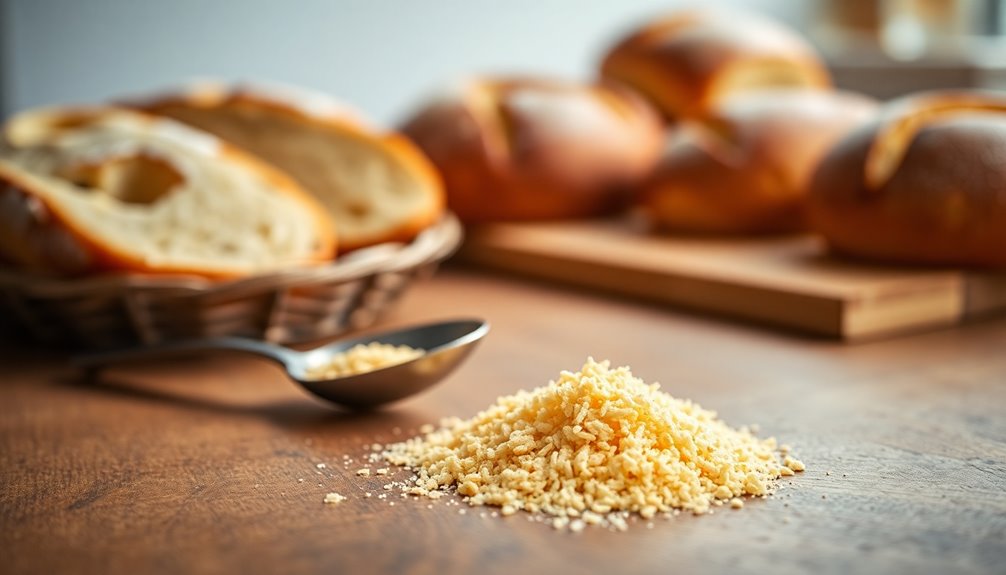
Yeast is essential in baking because it fuels fermentation, making your dough rise and creating that perfect texture.
It also plays a key role in developing rich flavors and aromas in your baked goods.
Understanding how yeast works can transform your baking results, ensuring delicious treats every time.
Yeast's Role in Fermentation
When baking, understanding yeast's role in fermentation is crucial for achieving the perfect rise and flavor in your dough. Yeast, whether you're using dry yeast or instant, converts sugars into carbon dioxide and alcohol, causing your dough to rise. This process isn't just about volume; it also creates the delightful taste you crave.
Here's why fermentation matters:
- Airy Texture: It gives your baked goods that light, fluffy quality.
- Complex Flavors: Fermentation develops deep, rich flavors in your bread.
- Aroma: It enhances the smell, making your kitchen irresistible.
- Temperature Sensitivity: Ideal fermentation occurs around 75°F to 80°F for best results.
Understanding these elements helps guarantee your baking is a success!
Impact on Dough Texture
Understanding fermentation lays the groundwork for appreciating how yeast impacts dough texture. The amount of yeast you use directly affects the dough's rise and overall texture.
When you measure 10g of yeast—about 3.2-3.3 teaspoons—you influence fermentation rates and gas production. Proper measurements guarantee your dough is well-aerated, resulting in a light, fluffy texture in baked goods like bread and pastries.
Using too much yeast can cause rapid fermentation, leading to a dense, gummy texture, while too little can leave you with a flat, dense product. The carbon dioxide produced during fermentation creates essential air pockets in the dough, making accurate yeast measurement vital for achieving the perfect texture in your baking.
Flavor Development in Baked Goods
While many may focus solely on yeast's role in making dough rise, its influence on flavor development is equally significant.
Yeast fermentation transforms sugars into alcohol and carbon dioxide, enriching the taste and texture of your baked goods.
Here are four ways yeast enhances flavor:
- Produces esters and phenols that create complex flavors.
- Longer fermentation times yield a more nuanced taste.
- Fresh yeast imparts a richer flavor, especially in brioche.
- The right yeast quantity balances quick rise and flavor complexity.
Tips for Successful Baking
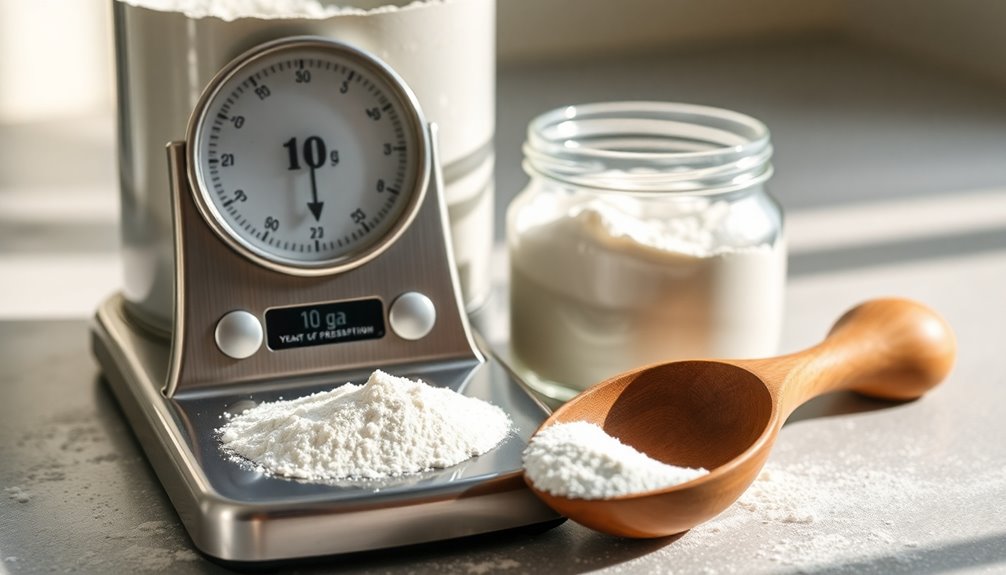
Successful baking hinges on precise measurements and careful techniques. When using a yeast converter, remember that 10 grams of yeast is about 3.2 to 3.3 teaspoons.
Always check the expiration date on your packets; expired instant dry yeast won't activate, leaving your dough flat. For best results, maintain water temperatures around 110°F (43°C) when activating dry yeast.
Also, allow sufficient proving time—fresh yeast may need longer than dry yeast to develop ideal flavor and texture. Experiment with yeast quantities to strike the right balance; too much can overpower your baked goods, while too little can make them dense.
Frequently Asked Questions
How Do You Measure 10G of Yeast?
To measure 10 grams of yeast, you'll want to use a digital scale for accuracy.
Place a bowl on the scale, tare it to zero, and add yeast until it reaches 10 grams.
If you don't have a scale, you can use teaspoons as a rough estimate; just remember that 2.8 grams of dry yeast equals about one teaspoon.
Always level off the teaspoon for consistency in your baking.
How Much Is 10 Grams of Fresh Yeast in Dry Yeast?
When you're converting 10 grams of fresh yeast to dry yeast, you should divide the amount by 3.
This means you'll need about 3.33 grams of dry yeast. Since one level teaspoon of dry yeast weighs roughly 2.8 grams, you can use about 1.2 teaspoons to replace that fresh yeast.
Keep in mind that this conversion is essential for achieving the right texture and rise in your baked goods.
How Many Teaspoons Is 10G?
When you measure 10 grams, you're looking at roughly 3.2 to 3.3 teaspoons.
If you want precision, use level teaspoons to guarantee consistency.
Remember, yeast density can vary, so accuracy matters.
By dividing the weight in grams by 3, you can estimate for dry yeast easily.
Whether you're baking bread or making pizza, knowing this conversion helps you achieve the perfect rise and texture for your delicious creations.
How Much Is 1 Tsp of Yeast in Grams?
If you're trying to figure out how much 1 teaspoon of yeast weighs in grams, you'll find it's about 2.8 grams.
This measurement can vary slightly depending on the yeast type or brand, so it's a good idea to check the product information for accuracy.
For baking consistency, using a kitchen scale for precise measurements is always recommended, especially when dealing with different recipes.
Happy baking!
Conclusion
In conclusion, when you're measuring 10 grams of yeast, it's roughly equivalent to about 2 to 2.5 teaspoons, depending on the type. Understanding yeast's unique properties can elevate your baking endeavors. So, whether you're whipping up wondrous breads or delightful doughs, remember that precise measurements and proper yeast selection pave the path to perfect pastries. With practice and patience, you'll master the art of baking, creating scrumptious treats that'll impress everyone around!









